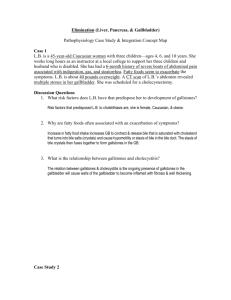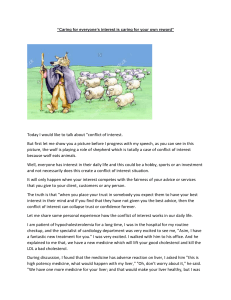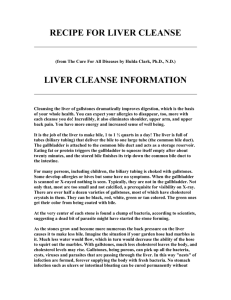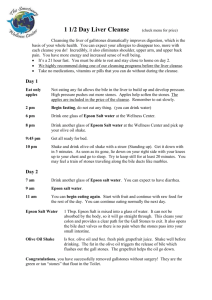Liver Cirrhosis: Causes, Symptoms, Treatment & Nursing Care
advertisement
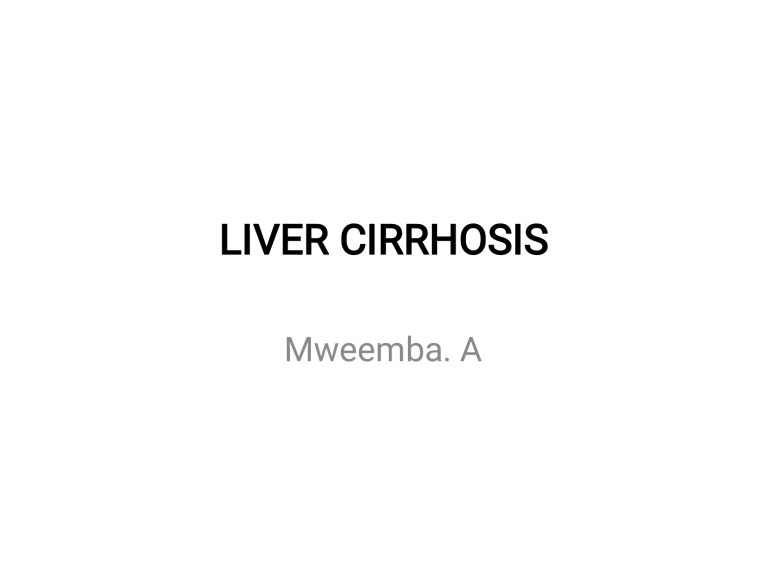
LIVER CIRRHOSIS Mweemba. A LIVER CIRRHOSIS Definitions • Liver cirrhosis is a chronic progressive disease of the liver characterized by extensive degeneration and destruction of the liver parenchymal cells (Lewis et al, 2011). • Liver cirrhosis is a progressive disease of the liver with a degeneration of the liver cells and infiltration of the liver by fibrous tissue. Causes • Dietary deficiency of protein (PEM and severe Kwashiorkor). • Alcoholism - It is believed that the combined impact of malnutrition and alcohol causes damage to the hepatocytes. • Alcohol alone has a direct hepatotoxic effect on the liver because its known to produce necrosis of cells and fatty infiltration. • Associated malnutrition (reduce protein intake) and damaged liver cells. Causes • Viral or toxic hepatitis - chronic inflammation and cell necrosis results in fibrosis and ultimately cirrhosis • Parasitic infection such as schistosomiasis, and repeated bouts of heart failure with liver congestion can all lead to liver cirrhosis • Metabolic disorders such as diabetes mellitus. • Blocked bile ducts - When the ducts that carry bile out of the liver are blocked, bile backs up and damages liver tissue. Causes • Autoimmune hepatitis- This condition can be caused by the immunologic damage to the liver causing inflammation and eventually scarring and cirrhosis. Pathophysiology • Early in the disease, the liver is enlarged and loaded with fat. • As liver cells are destroyed and replaced by scar tissue, it shrinks and becomes hard with a rough surface. Pathophysiology • As the liver fails to function properly the patient becomes jaundiced and has digestive problems. • Blood from the digestive tract which normally flows through the portal system to the liver is slowed down resulting in portal hypertension • This causes ascites, spleenomegally( large spleen), hemorrhoids, and oesophageal varices which may cause haemorrhage. • Since albumin is not produced well, there may be oedema and ascites. Signs and symptoms • Gastrointestinal problems: Anorexia, nausea and vomiting, dull abdominal pains, diarrhoea or constipation, dyspepsia due to the liver’s altered metabolism of carbohydrates and fats. • Hepatomegally due to fat infiltrating the liver cells. • Jaundice due to inability of the liver to conjugate bilirubin, compression of bile ducts by connective tissue overgrowth. • The jaundice may be minimal or severe depending on the degree of hepatic damage. Signs and symptoms • Portal hypertension due to obstruction of the venous system as a result of changes in hepatic vasculature • Fatigue due to decreased energy reserve as a result of the inability of the liver to metabolize carbohydrates • Hematologic problems-Anaemia due to increased destruction of red blood cells as a result of unconjugated bilirubin, poor diet, poor absorption of folic acid and bleeding from varices. Signs and symptoms • Hematologic problems-Coagulation problems resulting from the inability of the liver to produce prothrombin which is essential for blood clotting. • These problems are manifested by bleeding tendencies such as epistaxisis, petechiae, easy bruising, gingival bleeding and heavy menstrual bleeding. • Skin lesions: spider angiomas (telangiectasis or spider nevi) are small dilated blood vessels with a bright red centre point and spider like branches. Signs and symptoms • Skin lesions: These occur on the nose, cheeks, upper trunk, neck and shoulders. • Palmar erythema- a red area that blanches with pressure is located on the palms of the hands. • These lesions are attributed to an increase in the circulating oestrogen as a result of the damaged liver’s inability to metabolize steroid hormones. Signs and symptoms • Endocrine disturbances. Normally, the liver is supposed to metabolize hormones such as oestrogen and testosterone. • When the liver is damaged, its unable to carry out these functions. • In men, gynaecomatia, loss of axillary and pubic hair, testicular atrophy, impotence with loss of libido may occur due to oestrogen accumulation. • In younger women, amenorrhoea may occur and in older females vaginal bleeding may occur. Signs and symptoms • Aldosterone metabolism is impaired resulting in hyperaldosteronism with subsequent sodium and water retention and potassium loss. • Finger clubbing • Ascites - Accumulation of fluid in the peritoneal cavity • Pluritis Diagnosis • History taking – Patient may reveal excessive alcohol intake or recent exposure to hepatitis B or C. • Physical examination may reveal yellowish discoloration of the mucous, hepatomegally and ascites. • Liver function test will show elevated levels of AST (Aspartate Amino Transferase) and ALT (Alanine Amino Transferase ) bilirubin and serum albumin will be reduced. Diagnosis • Liver biopsy for analysis to detect chronic active disease,, progression and response to therapy. • Barium swallow will show oesophageal varices. • Bleeding and clotting time-bleeding time will be increased whereas clotting time will be reduced. • Computed axial tomography (CAT) scan will show calcification of the liver. • Ultrasound scan will show enlargement of the liver. Treatment • Treatment depends on the cause and stage of the cirrhosis. • It is aimed at stopping the progress of the cirrhosis, reversing (to whatever extent possible) the damage that has already occurred, and treating complications that are disabling or life-threatening. • Stopping or reversing the process requires removal of the cause, as in the following cases. Treatment • In alcoholic cirrhosis: abstinence from alcohol and intake of an adequate wholesome diet. • In cirrhosis caused by viral hepatitis: use drugs such as interferone to improve the immune responses of the infections or to help destroy the virus. • Administer corticosteroids such as Prednisolone in chronic hepatitis. • Administer supplemental fat soluble vitamins such as vitamin A.D.E.K • Vitamin B12 for anaemia Treatment • Potassium sparing diuretics diuretics such as aldoctone or spinorolactone 25mg qid to reduce oedema and ascites. • In severe cirrhosis, a liver transplant may be life-saving • Abdominal paracentesis in cases where patient has ascites (accumulation of fluids in the peritoneal cavity) to relieve abdominal pressure but otherwise should be avoided because it removes protein. Treatment • Vasopressin maybe indicated for oesophageal varices. • Alcohol is prohibited and sedatives should be avoided. • Liver transplant • Avoid drugs which are metabolized by the liver e.g. sedatives, narcotics Nursing care Environment • The environment should be well ventilated and warm as patient tends to be feverish. • It should also should be clean to prevent infections. POSITION • The patient is nursed in a semi sitting position to promote maximum respiratory function. This is so because the patient has severe dyspnoea due to pressure of the liver on the diaphragm and also due to Ascitis. REST AND SLEEP • The patient finds it difficult to sleep due to discomfort. • Ensure that the patient rests adequately to promote quick recovery of the liver and establish its function. • Ensure that environment is quite and do similar nursing activities correctly such as bathing, pressure area care, nail care and oral care. OBSERVATIONS • Temperature, pulse and respirations are taken every four (4) hours in order to detect a rise or drop in temperature and to monitor if there is any improvement. • A rapid pulse is a good indicator of haemorrhage, rapid respirations due to pressure on the diaphragm • Blood pressure is checked also in order to detect on set of shock or gastrointestinal bleeding. OBSERVATIONS • Monitor the degree of jaundice that is mild, moderate and severe. • Measure the abdominal girth as it is a good indicator of Ascitis. • Measure weight daily in order to assess for improvement • Monitor for vomiting; colour, amount, blood and its volume • Observe the level of consciousness to detect early onset of hepatic coma. DIET • The patient should be given a diet rich in calories, glucose drink, a high protein diet unless the patient is in coma or has a high level of blood urea. • In late disease, proteins may have to be restricted as liver is unable to metabolise it. • Small frequent meals should be given as the patient tends to have poor appetite. DIET • Give low salt diet because of Ascitis as there is a tendency of accumulation of sodium. • The patient should be advised to eat slowly as there is a tendency to have abdominal pains. • Restrict sodium intake because of the ascites and oedema. • Advise patient to stop alcohol consumption because it can cause more damage to liver cells. ELIMINATION • The patient should be given aperients or laxatives to allow them to have pain free bowel motions. • If the patient has haemorrhoids give annusol suppositories to help minimise pain and oedema associated with haemorrhoids. • Observe the stool for malaena and blood stain. • The diet should have plenty of roughage and easily digestible food to prevent rectal bleeding. HYGIENE • The following hygienic needs should be met as the patient is usually weak; give daily baths, four hourly assisted oral care to promote comfort, blood circulation and infections. • PSYCHOLOGICAL CARE • The disease causes emotional and psychological distress to the patient. • The patient must be assured that the condition can be controlled though it takes long. • Ensure compliance from the patient and explain the condition to the relatives. ADVICE ON DISCHARGE • Need to have adequate rest at home as the patient tends to have fatigue due to the inability of the liver to store glucose which is needed for energy. • To change the occupation if it’s demanding to avoid stress. • Avoid un prescribed and over the counter drugs to avoid casing more damage to the liver which is already diseased ADVICE ON DISCHARGE • Advise the patient to come for review but can come back to the hospital if symptoms persist before the review date such as: confusion, dyspepsia, drowsiness, increase in the level of ascitis and jaundice so that he can be observed closely • The normal review is after six (6) weeks. • To stop drinking alcohol as this may cause more damage to the liver and hence retard recovery. Complications Portal hypertension • Portal hypertension is characterized by increased pressure in the portal circulation as well as spleenomegally, large collateral veins, Ascitis, systemic hypertension and oesophageal varices. • Collateral circulation is as a result of an attempt to reduce the high portal pressure, reduce the increased plasma volume and lymphatic flow in the lower oesophagus, anterior abdominal wall, the parietal peritoneum and the rectum. Complications Oesophageal Varices • Oesophageal varices are due to the tortuous veins at the lower end of the oesophagus, enlarged and swollen due to portal hypertension. • The varices rupture and bleed in response to ulceration and irritation due to alcohol ingestion, swallowing of poorly masticated food, ingestion of coarse food, acid regurgitation from the stomach Complications Oesophageal Varices • Increased intraabdominal pressure caused by nausea, vomiting, straining at stool, coughing, sneezing or lifting heavy objects. • The patient may have malaena stool and haematemesis. Excessive haemorrhage is an emergency Complications Peripheral Oedema and Ascitis • There is an impaired synthesis of albumin by the liver which leads to decreased oncotic pressure Liver cancer • Hepatocellular carcinoma, a type of liver cancer commonly caused by cirrhosis, starts in the liver tissue itself. • It has a high mortality rate. Complications Liver Failure • Leading to hepatic encephalopathy. Renal Failure • Due to reduced blood flow to the kidneys. Anaemia • Due to bleeding tendencies, loss of iron and hypoproteinaemia. • Severe generalized infection BILLIARY DISORDERS CHOLELITHIASIS/CHOLEDOCHOLITHIASIS Definitions • Cholelithiasis is the presence of gall stones in the gallbladder. • Choledocholithiasis is the presence of gallstones in the bile ducts. Formation of Gallstones • Gallstones are hard, pebble-like deposits that form inside the gallbladder. Formation of Gallstones • Gallstones may be as small as a grain of sand or as large as a golf ball. • Gallstones form when bile stored in the gallbladder hardens into pieces of stone-like material. • Bile contains water, cholesterol, fats, bile salts, proteins, and bilirubin – a waste product. • If the liquid bile contains too much cholesterol or bilirubin or reduced bile salts, it can harden into gallstones. • The reason for the imbalances is not known. 2 types of gallstones Cholesterol stones • Made out of hardened cholesterol. • These are the most common type of gallstones. Cholesterol stones are usually yellow-green. Pigment stones • Made from too much bilirubin in the bile. • Pigment stones are small, dark stones. Gall Stones Incidence of Cholelithiasis/ choledocolithiasis • The condition affects both sexes at any age but more females are affected than males, and incidence increases with age especially over the age of 40. Cause/Aetiology • The cause of gallstones is not fully known. • The stones tend to develop in people who have liver cirrhosis, biliary tract infections, or hereditary blood disorders such as sickle cell anaemia, in which the liver makes too much bilirubin. Risk Factors Sex • Women are twice as likely as men to develop gallstones. • Excessive estrogen from pregnancy, hormone replacement therapy, and contraceptive pills appears to increase cholesterol levels in bile and decreases gallbladder movement, which can lead to gallstones. Family history of gallstone • Gallstones often run in families. Risk Factors Obesity • Being moderately overweight increases the risk for developing gallstones. • The most likely reason is that the amount of bile salts in bile is reduced, resulting in more cholesterol. • Increased cholesterol reduces gallbladder emptying. Risk Factors Diet • Diets high in fat and cholesterol and low in fiber increase the risk of gallstones due to increased cholesterol in the bile and reduced gallbladder emptying. Rapid weight loss • As the body metabolizes fat during prolonged fasting and rapid weight loss, the liver secretes extra cholesterol into bile, which can cause gallstones. In addition, the gallbladder does not empty properly. Risk Factors Age • People older than 60 years are more likely to develop gallstones than younger people. • As people age, the body tends to secrete more cholesterol into bile. Ethnicity • Some races have a genetic predisposition to secrete high levels of cholesterol in bile e. g. American Indians. Risk Factors Cholesterol-lowering drugs • Drugs that lower cholesterol levels in blood actually increase the amount of cholesterol secreted into bile. • In turn, the risk of gallstones increases. Diabetes: • People with diabetes generally have high levels of fatty acids called triglycerides. • These fatty acids may increase the risk of gallstones. Signs and Symptoms • As gallstones move into the bile ducts and create blockage, pressure increases in the gallbladder and one or more symptoms may occur. • Symptoms of blocked bile ducts may have an abrupt onset. • Gallbladder attacks often follow fatty meals, and they may occur during the night. • The signs and symptoms include: Signs and Symptoms Pain in the right upper or middle upper abdomen • May go away and come back • May be sharp, cramping, or dull • May spread to the back or below the right shoulder blade • Occurs within minutes of a meal Signs and Symptoms • Fever, even low grade or chills • Yellowish discolouration of the skin and sclera • Abdominal fullness • Clay coloured stools • Nausea and vomiting • Fat intolerance (indigestion, pain bloating and belching) Signs and Symptoms Note • Many people with gallstones are asymptomatic. • The gallstones are often discovered when having a routine x-ray, abdominal surgery, or other medical procedures. • These do not need treatment. MEDICAL MANAGEMENT OF A PATIENT WITH CHOLELITHIASIS Investigations • Abdominal ultrasound: will show the location and size of gallstones in the biliary tract. • This is the most sensitive and specific test for gallstones. • Computerized Tomography (CT) Scan: • A non-invasive x-ray that produces crosssection images of the body. The test may show the gall stones or complications, such as infection and rupture of the gallbladder or bile ducts. MEDICAL MANAGEMENT OF A PATIENT WITH CHOLELITHIASIS • Cholecystography - the patient is injected with a small amount of nonharmful radioactive material that is absorbed by the gallbladder, the x-ray will show an opaque gall bladder with gall stones which will be seen as dark spots. • Blood tests: blood tests may be performed to look for signs of infection, obstruction, pancreatitis, or jaundice e.g. bilirubin, liver function tests and pancreatic enzymes. MEDICAL MANAGEMENT OF A PATIENT WITH CHOLELITHIASIS • Endoscopic Retrograde Cholangiopancreatography (ERCP): ERCP is used to locate and remove stones in the bile ducts. • After lightly sedating the patient, an endoscope is inserted down in the oesophagus and through the stomach and into the small intestine. • A special dye is injected so that the affected bile duct and the gallstone are located on a monitor. • The stone is captured and removed with the endoscope. Differential Diagnosis • Heart attack, appendicitis, peptic ulcers, irritable bowel syndrome, hiatus hernia, pancreatitis, and hepatitis. Aims of Management • To control pain • To control possible infection with antibiotics • To maintain fluid and electrolyte balance Drug Therapy Oral dissolution therapy • Chenodeoxycholic acids (CDCA, Chenodiol): dissolution of cholesterol stones. 250mg P.O. b.i.d for the first 2 weeks, followed, as tolerated, by weekly increases of 250mg/day, up to 13 to 16 mg/kg/day for up to 24 months. • Ursodeoxycholic acid (UDCA, Ursodiol, Actigall): dissolution of gallstones less than 20mm in diameter when surgery is not possible. 8 to 10mg/kg P.O. daily in two or three divided doses for 12 to 24 months. Drug Therapy Contact dissolution therapy • Methyl tert-butyl ether: this drug is still being experimented. • It is injected directly into the gallbladder to dissolve cholesterol stones. Supportive Treatment • Analgesics for pain (opiod analgesics) • Antispasmodics or anticholinergics to decrease secretions (which prevent biliary contraction) and counteract smooth muscle spasms e.g. dicyclomine • Antiemetics to control nausea and vomiting. • Antibiotics to eliminate infection. Treatment • If the above treatment fails, surgery is performed and this includes: • Cholecystectomy - removal of gallbladder. • Cholecystostomy (usually an emergency) incision into the gallbladder to remove stones. Complications of Cholelithiasis • Infection of the gallbladder - the presence of the gall bladder may lead to infection. • Rupture of the gallbladder • Acute cholecystitis may develop if the gallstone becomes stuck in the neck of the gall bladder causing inflammation. • Cancer of the gallbladder due to continued irritation. Complications of Cholelithiasis • Pancreatitis which may be due to blockage of the pancreatic duct caused by gall stone. • Small bowel obstruction and paralysis due to gallstone causing obstruction. • Obstructive jaundice caused by presence of gall stone in the bile CHOLECYSTITIS Definition: this is the inflammation of the gall bladder. • Cholecystitis can either be acute or chronic. Aetiology (causes) • Obstruction caused by gallstones or biliary sludge • Following trauma, extensive burns or recent surgery • Prolonged total parenteral nutrition and diabetes mellitus Aetiology (causes) • Bacteria reaching the gallbladder via the vascular or lymphatic route • Chemical irritants in the bile • Adhesions, neoplasm, anaesthesia and narcotics • Inadequate blood supply Causative organisms (for bacterial causes of acute cholecystitis only) • Escherichia coli (most common) • Streptococci • Salmonella Clinical Features • Episodes or vague pain in the right upper quadrant of the abdomen that radiates to the right shoulder • Pain is triggered by a high fat or high volume meal Clinical Features • • • • Anorexia Nausea and vomiting Dyspepsia Mild to moderate fever Acute abdominal tenderness and a positive Murphy’s sigh (Palpation of abdomen causing severe increase in pain and temporary respiratory arrest) • Patient may wake up at night due to pain • Jaundice • Clay colored stool Diagnosis • Classical sign and symptoms pain in the right upper quadrant of the abdomen that radiate to the shoulder usually precipitated by consumption of fat diet. Positive Murphy’s sign • Ultrasound will reveal inflamed gall bladder. • Liver function tests will be altered • MRI may also be very useful where available Management Medical • Anti‑spasmodics (Atropine, Probanthine) • IV fluids, • Antibiotics for acute attack for example, ampicillin, or septrin • Analgesia such as Pethidine 100 mg. Surgical- surgery is indicated where patient does not respond to medical treatment. • Cholecystectomy‑‑removal of gall‑bladder Nursing Care of a Patient with Cholelithiasis and cholecystitis • If the gallstones cause no symptoms, the patient should be left alone. • No treatment should be given. • However, hospitalization may be required if patient’s pain lasts more than six hours. Pain Relief • When patient has biliary colic, the patient should remain in bed and pethidine administered. Pain Relief • If it is not possible to administer pethidine, • Antispasmodic drugs such as atropine, propantheline or nitroglycerin and morphine should be administered to relief painful reflex spasm that occurs in response to the stone in a duct. • Local applications of heat to the upper abdomen may be done. Diet • During an episode of biliary colic, the patient should not be given anything by mouth but administer the prescribed intravenous fluids. • If vomiting and abdominal distention occur, a nasogastric tube is passed for suctioning in order to decompress the stomach. • Local applications of heat to the upper abdomen may be ordered. Diet • After the acute episode and removal of the nasogastric tube, clear fluids are given and gradually increased to a light, low fat diet as tolerated. • Patient should be given replacement of fat soluble vitamins. • Bile salts are also administered to facilitate digestion and vitamin absorption. • If the patient is overweight, weight reduction should be considered. • Provide low fat diet. Diet • Foods to be avoided include; dairy products such as whole milk, ice cream, cheese, fried foods, gravies, nuts. Activity • There should be no restrictions of activity except during attacks of gallbladder colic when patient is advised to rest. Observations • Observe the patient’s skin and sclera for signs of jaundice. Observations • Observe the colour of stool, if pale, there is an obstruction in the biliary duct and therefore a daily dose of vitamin K is given parenterally to maintain prothrombin formation and prevent bleeding. • Also examine the stool for the presence of stones passed from the biliary tract into the intestine. • Vital signs observations should be done twice daily unless the patient develops fever in which case observe four hourly. Complications of Cholecystitis • Perforation • Gallstones • Cholangitis due to spread of infection along the bile ducts, causing jaundice • Empyema (pus in the gallbladder) • Gangrene (tissue death) of the gall bladder • Pancreatitis • Peritonitis (inflammation of the lining of the abdomen) Questions • Thank You

